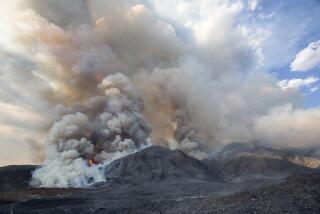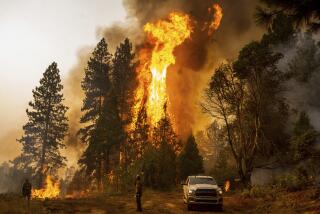U.S. may be producing 50% more methane than EPA estimate indicated

- Share via
The United States may be emitting 50% more methane, a potent greenhouse gas, than the federal government had previously estimated, according to a new study in the Proceedings of the National Academy of Sciences.
Though carbon dioxide from the combustion of fossil fuels is the main driver of climate change, and less methane than carbon is emitted overall, methane is an even more powerful heat-trapping gas than carbon.
In April, the Environmental Protection Agency said that better pollution control by the oil and gas industry had resulted in an average annual decrease of 41.6 million metric tons of methane from 1990 to 2010. That was roughly 20% lower than earlier estimates by the agency.
The EPA’s findings bolstered supporters of the domestic oil and gas boom, who claimed that fossil fuels could be extracted without methane leaks and flaring worsening greenhouse gas emissions. But the report this week from an international team of researchers tells a different story.
The study was conducted by Scot M. Miller, a doctoral student in Earth and planetary sciences at Harvard University, and researchers from seven other institutions. The team took a different approach from the EPA’s to measuring methane. It analyzed almost 5,000 air samples collected in 2007 and 2008 from tall towers around the country and more than 7,700 samples gathered over the same period by research aircraft operated by federal agencies.
Researchers found that methane from Texas, Oklahoma and Kansas was 2.7 times higher than previously recorded, driven mainly by oil and gas development. Those three states alone account for nearly one-quarter of U.S. methane emissions and almost 4% of the country’s overall output of greenhouse gases, according to the study.
The researchers also found that methane emissions from livestock are twice as high as earlier measurements.
“These results cast doubt on the U.S. EPA’s recent decision to downscale its estimate of national natural gas emissions by 25-30%,” the study concluded.
The PNAS study is certain to roil the debate about the feasibility of agriculture, industry and regulators’ current approach to reducing methane emissions. EPA spokeswoman Alisha Johnson said the agency was reviewing the new study and welcomed the information.
“EPA … continually seeks opportunities to update and improve our estimates,” Johnson said. “Research studies like these will add to our knowledge base of GHG [greenhouse gas] emissions and will help us refine our estimates going forward.”
The study arrives two months after another research paper in PNAS found that well-completion work at oil and gas extraction sites emitted less methane than EPA estimates, but other phases of production showed higher levels of methane leakage from valves and other equipment at well sites. The EPA does not regulate emissions from the equipment, the authors of the September study said.
Last week, Colorado proposed new rules to reduce methane leaks from oil and gas operations. It’s the first effort in the country to address emissions of the greenhouse gas that is a byproduct of the domestic fossil fuel boom.
The state has rules in place to curb emissions of methane, the primary component of natural gas, during drilling. The proposed new rules call for detecting and repairing methane leaks throughout a company’s infrastructure, such as from the equipment at the well pad, in above-ground pipelines and at compressor stations.
Methane emissions in the United States dropped slightly from 2011 to 2012, according to federal data. But emissions from oil and gas operations have risen in Colorado and other states where energy production is roaring, according to the Environmental Protection Agency.
“We are glad to see the methane issue getting the attention it deserves,” said Steven Hamburg, chief scientist for the Environmental Defense Fund, which worked with Colorado on its new methane rules. “There’s no question about the need for regulation to measure and reduce these emissions.”
ALSO:
Environmental Protection Agency names new scientific integrity chief
Video: A flying robotic jellyfish? Prototype proves it’s possible
The chemistry of love: Oxytocin may drive monogamy in relationships
“Like” Los Angeles Times Science & Health on Facebook.







